Items
topic_interest is exactly
Navajo Nation
-
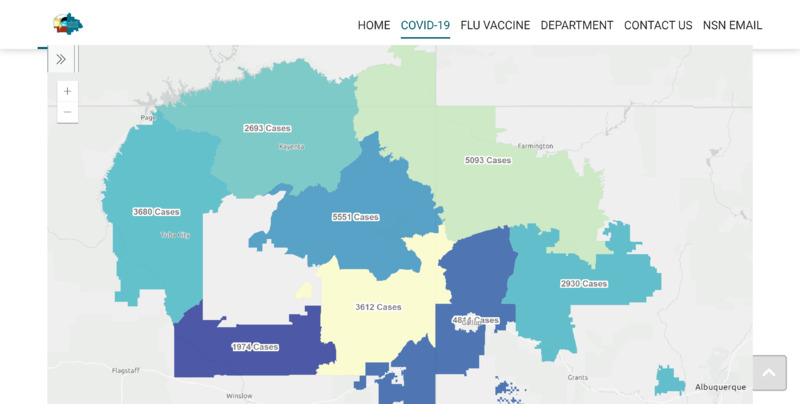 2021-04-19
2021-04-19Navajo Department of Health COVID-19 Case Infection Data by Region through 19 April 2021
This image, taken as a screenshot from the Navajo Department of Health website on 19 April 2021, shows COVID-19 infection case data by region within the Navajo Nation. -
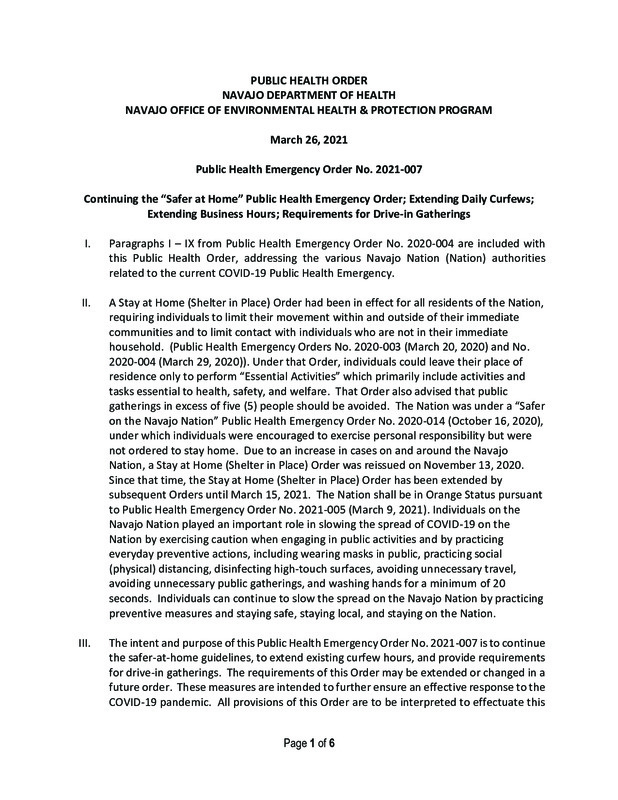 2021-04-19
2021-04-19Navajo Department of Health Public Health Emergency Orders through 19 April 2021
These eight documents are the eight Public Health Emergency Orders issued by the Navajo Department of Health issued through 19 April 2021. -
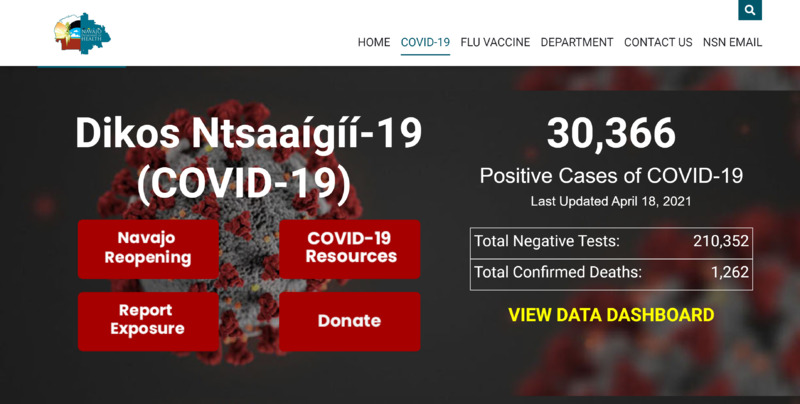 2021-04-19
2021-04-19Navajo Department of Health Data & Website
Despite recent data and statistical successes, the NDOH has left its 10pm to 5am curfew in place. The site offers a dashboard with current COVID-19 information, in terms of both resources and data. -
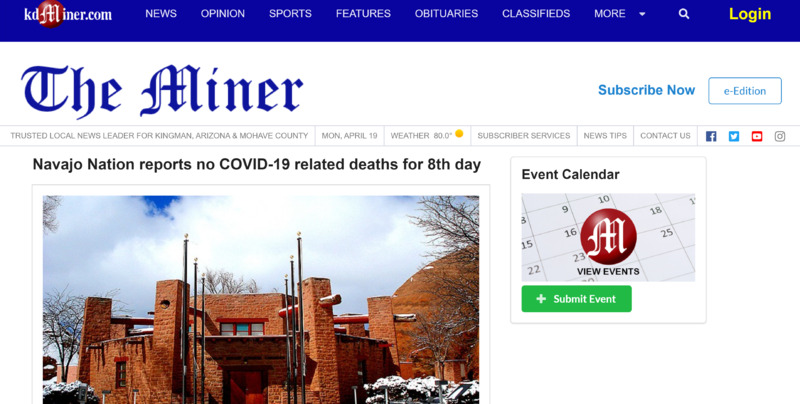 2021-04-19
2021-04-19News Article: Navajo Nation reports no COVID-19 deaths for 8th day
By Associated Press, 19 April 2021 WINDOW ROCK (AP) — The Navajo Nation is finding no new COVID-19 related deaths for an eighth consecutive day. The tribe on Sunday afternoon reported seven new virus cases but no additional deaths on the vast reservation. The latest numbers bring the Navajo Nation's pandemic case total to 30,366 with the death toll remaining at 1,262. Tribal officials said 16,477 people have recovered from COVID-19 thus far. The tribe had been easing into reopening but that slowed somewhat after coronavirus variants were confirmed on the reservation, which stretches into New Mexico, Utah and Arizona. Tribal officials urged residents to stay vigilant. Navajo President Jonathan Nez said the tribe recently had a cluster of COVID-19 cases as a result of a family gathering where people were not wearing masks. Tribal public health orders mandate that masks be worn on the reservation and a daily curfew is in effect. Restaurants cannot have dine-in services. Navajo Nation roads also are closed to visitors and tourists, which doesn’t affect travel on state highways that run through the reservation. Meanwhile, health care facilities across the reservation continue to offer the vaccine by appointment or at drive-thru events. -
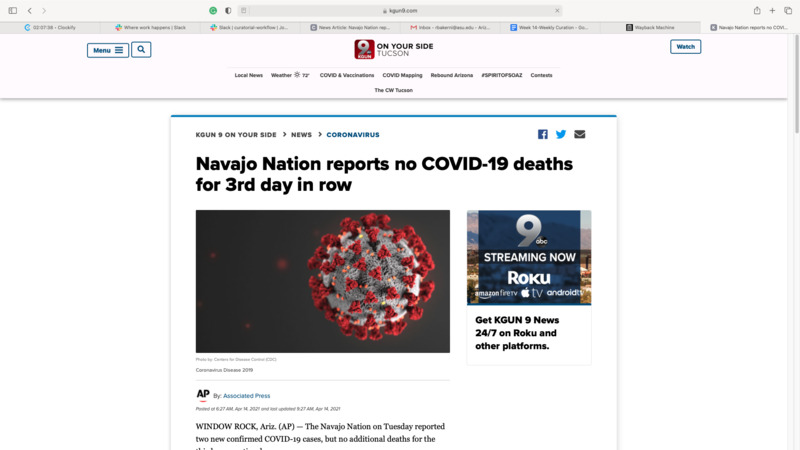 2021-04-14
2021-04-14News Article: Navajo Nation reports no COVID-19 deaths for 3rd day in row
Despite very grim months through the last year's COVID-19 pandemic in the Navajo Nation, the Associated Press reported continuing indications of success for the Navajo people and their rural communities: WINDOW ROCK, Ariz. (AP) — The Navajo Nation on Tuesday reported two new confirmed COVID-19 cases, but no additional deaths for the third consecutive day. The latest numbers brought the pandemic totals on the tribe’s reservation to 30,269 cases and 1,262 known deaths. Tribal officials had ordered a lockdown last weekend over fears that a new variant could drive another deadly surge. The Stay-At-Home order required all Navajo Nation residents to refrain from unnecessary travel to help limit the spread of the virus, including a new and more contagious strain. Navajo Nation President Jonathan Nez recently announced the first confirmed case of the COVID-19 B.1.429 variant on the reservation that covers parts of Arizona, New Mexico and Utah. -
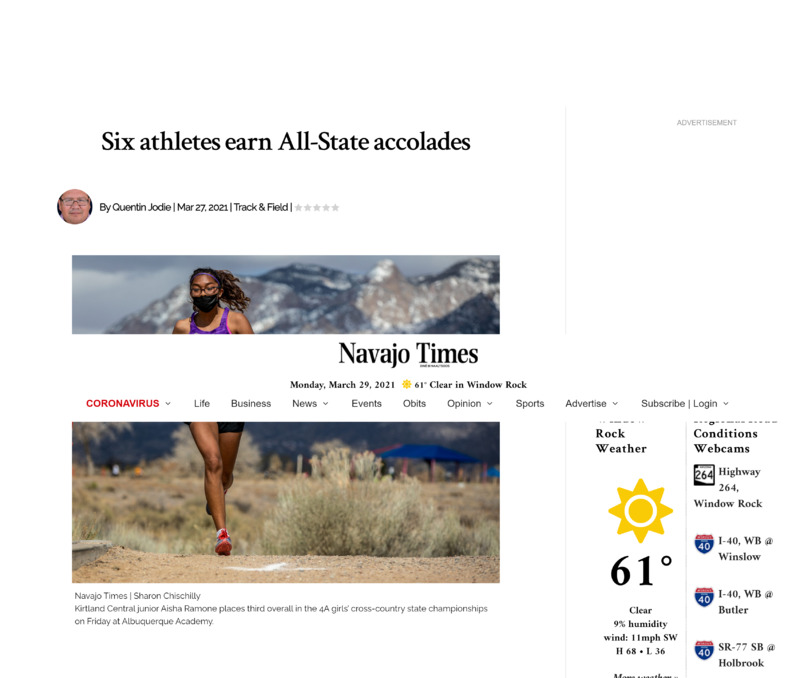 2021-03-27
2021-03-27Running Masked Up: Six Navajo Nation Athletes Earn All-State Accolades
By Quentin Jodie | Mar 27, 2021 | Track & Field | Navajo Times | Sharon Chischilly Kirtland Central junior Aisha Ramone places third overall in the 4A girls’ cross-country state championships on Friday at Albuquerque Academy. ALBUQUERQUE It’s been a long time coming for the Tohatchi boys’ cross-country team. On Friday, the Cougars placed four runners in the top 20 at the New Mexico Class 3A state cross-country meet as they secured the second-place trophy. “It’s been a while since we took one of these home,” Tohatchi coach Fern Spencer said of the red trophy. The longtime coach is not sure when was the last time they brought home a state trophy in cross-country but she said it was well deserved. “It’s very good for the program,” she said when asked if the state runner-up trophy is a nice addition to the trophy case. “They’re all young so we have another year with them. We’re going to continue to work hard and keep improving.” The Cougars were not the only school to take home hardware as six athletes earned All-State honors. In the 4A girls’ race, Kirtland Central’s Aisha Ramone and Shiprock’s Kaydence Platero placed third and fourth, respectively. “Finishing in the top three was my main goal and I got it,” Ramone said, who finished the 5K race in 19:47.77. “I just felt like I could have stayed up with the Albuquerque Academy runner (Emma Patton) but I just didn’t dig deep down enough to finish second.” Nonetheless, the KC runner was happy that she improved from last season’s sixth place finish at state. Platero was another runner who saw improvements from last year as she jumped four spots to fourth this year. “I’m so happy that I made the top five,” Platero said. “This is a big morale boost for me because I didn’t have a lot of confidence in myself but my team, my coach and the whole town of Shiprock cheered me on.” Platero, who was clocked in at 20:00.26, said her game plan worked to near perfection as she tried to shadow Ramone. “I tried to hang with Aisha and I tried to execute that but they did take off,” she said. “But in the end I was still able to finish behind them.” With a team score of 83 points, the Aztec Lady Tigers placed fourth while Shiprock took fifth with 94 points. In the 4A boys, Miyamura’s Tayan Benson made the podium with a 10th place finish. “I was hoping to do better than last year, but I just couldn’t do that today,” the Miyamura junior said. In the team standings, the Shiprock Chieftains placed fourth while Miyamura took sixth. In the 3A boys’ race, Albuquerque Cottonwood Classical ran away with the state title with 14 points while the Cougars finished with 47 points. Tohatchi was led by Nicolas Yazzie as he placed 10th overall. “It means a lot to us,” Yazzie said. “We all come in every day to practice and we give it our all. It just led to this moment and I think the time and effort we put into this paid off. I couldn’t have done it without them.” In addition to Yazzie, the Cougars had Melvin Scott Jr. place 14th, Jimmie Chavez III 17th and Jared Peterson 20th to complete the team score. Tohatchi’s fifth runner, Rodney Joe placed 30th overall. Individually, Crownpoint’s Tylon Tsosie and Newcomb’s Damien Johnson were named to the 3A All-State team by placing in the top 10. Tsosie took seventh, one spot ahead of Johnson. In the 1A/2A meet, the Ramah girls and Rehoboth boys took fifth in their respective races. -
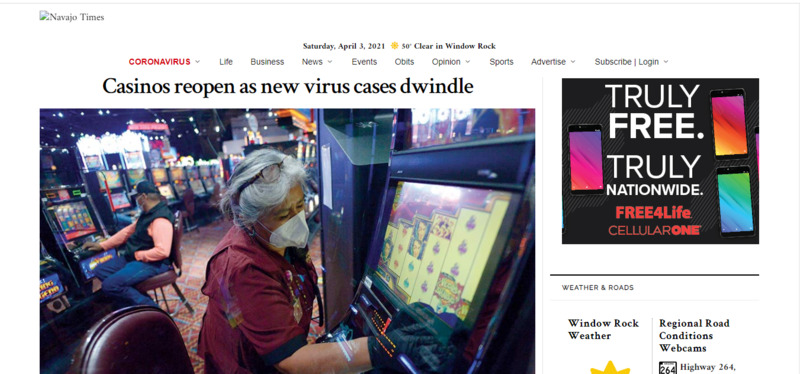 2021-03-25
2021-03-25Navajo Nation casinos reopen as new virus cases dwindle
By Donovan Quintero | Mar 25, 2021 | Business, CORONAVIRUS | CHURCH ROCK, N.M. Peterson Zah has a concern. On Tuesday, while hundreds of Fire Rock Casino patrons tried to win some money, the former Navajo Nation president wanted to hear what the COVID-19 public service announcement sounded like in Navajo. “I didn’t hear any of the PSA while inside because it’s so noisy,” he said. After taking a step outside the casino, the former Navajo Nation president said he was able to hear it. But that raised a concern for him. “And it’s pretty good,” Zah said, explaining the PSA in Navajo was clear and concise. “But you can only hear that clear outside and inside you can’t really understand it.” Zah said he was concerned no one would hear the COVID-19 safety guidelines everyone needed to follow. His other concern was that since many Navajo people have gotten both doses of the vaccines, many of them might become emboldened. “The reason why I was concerned is people have this attitude that because of the shots … they say, ‘Hey, I’m immune, I don’t have to worry about the virus.’ So when I go places I’m gonna take mine (mask) off,”’ Zah said Tuesday. According to the president’s office, more than 76,000 people have been fully vaccinated as of March 23 and more than 191,000 total doses have been administered. Zah didn’t think people should take any chances by easing up on protecting themselves from the contagious respiratory virus because some people were not wearing masks. After being closed for more than a year, Fire Rock Casino and Northern Edge Casino were on the fifth day of a two-week “soft reopening.” Just the gambling portion of the casinos were open at 25% capacity, and only Navajo Nation residents were allowed into the casinos, according to Navajo Gaming interim CEO Brian D. Parrish. Parrish clarified Navajo Nation residents meant everyone, including non-Natives, living on the reservation would have access to the casinos during the reopening phase. “We’re doing it with a two-phase reopening plan that started with Fire Rock and Northern Edge first,” he said. “We’re going to reevaluate with the Navajo Nation. They’re going to do audits and monitor our implementation of our workplace safety plan.” Of the 1,180 casino employees, 650 have returned to work since last Friday, said Parrish. Employees like Fire Rock Casino housekeeper Mildred Russell, who said she’s been out of work for over a year, were happy to be working again. “It’s been a struggle,” Russell said while cleaning a slot machine last Friday. “Hopefully this pandemic will be gone and everybody can go back to their normal lives.” Other employees, like casino security officer Vernon Keeswood from Hogback, New Mexico, shared Russell’s gratitude for getting the call to go back to work. “It’s good,” he said on Tuesday during a telephone interview that was arranged by Michele J. Crank, executive director of communications and public relations for Navajo Nation Gaming Enterprise. Instead of the usual hugs and shaking hands, Keeswood said, now it was “fist bumps” and “elbow bumps.” As for the reopening, he said many Northern Edge Casino customers “are pleased and happy” the Navajo casinos have begun reopening. He added a few customers were not sure if the casinos should reopen. “I hope everyone washes their hands and practices social distancing so we open to 100 percent capacity,” Keeswood said. “I hope it opens more.” After all, the threat of another COVID-19 outbreak looms on everyone’s mind, including that of Robert Peterson from Thoreau. “People are still afraid to come here but a lot of them want to enjoy being out instead of being stuck at home,” said Peterson, who said he lives alone, last Friday. Peterson said being alone and dealing with the pandemic has been hard for him. Despite his fears, he decided to head to Fire Rock to get his mind off COVID-19. Mary E. Silversmith, 79, from Lupton, Arizona, ensured no one came to visit her with a “no visitors allowed” sign posted on her hogan. She was happy to support the casino employees who returned to work. “The casinos were opened for the casino employees,” she said on Tuesday at Fire Rock. “Many of have children and they have bills to pay. “Because of that, I am OK with the reopening,” she said. “Some people have been criticizing the reopening. Not me, I don’t think that way or talk that way.” Before the pandemic, Silversmith said she frequently ate at Fire Rock, as well as at Twin Arrows Casino and Resort, when she had extra money to spend. Silversmith was wearing a surgical mask. To gain entry into both casinos during the soft reopening, a state ID, like a driver’s license, is required and a working number at which customers can be contacted. Temperature checks were also part of the requirements for anyone wanting to enter. After their temperature was checked, security asked customers to momentarily remove their masks and look at the front entrance security camera. The purpose of collecting all of the information is for contact tracing, said Parrish. “We have an excellent plan that’s in place,” he said. “We’ve had it reviewed and modified and enhanced by public health experts, not only on Navajo, but outside the Navajo Nation.” He added that Navajo Gaming invested close to $2 million in “equipment, supplies, signage, training,” to keep everybody safe. U.S. Indian Health Service officials toured both of the casinos’ kitchens on March 12, Parrish added, to review their safety procedures. “And in terms of reopening of the other properties, especially at a higher capacity percentage, that’s going to be based not only on how well the enterprise does, but what’s happening with the public health metrics, the rate of vaccinations on Navajo and other key indicators like that,” the interim CEO said. The Navajo Gaming enterprise’s careful planning even got praise from Jordan Schermerhorn, a senior research associate at Georgetown Center for Global Health Science and Security. Schermerhorn stated in an email to NNGE their plan showed the tribe was leading “the entire country in a smart, careful return to normalcy.” “Combined with the Navajo Nation’s outstanding vaccine rollout, this soft reopening shows what is possible with a data-driven pandemic response in a community dedicated to public safety,” Schermerhorn‘s email said. Even the ventilation, air conditioning and heating systems, which completely re-circulate the air inside the casinos 15 times a day, were reviewed, said Parrish. “We’re ready to go to fifty percent, we’re ready to offer food and we’re ready to bring the rest of our team back,” Parrish said. Zah watched casino patrons trying to win money as sounds from the Tuesday afternoon hustle and bustle all but drowned out the COVID-19 PSA. “So basically, the attitude shouldn’t be such now that because they got their shot they don’t have to worry about it,” he said. “It’s still around. Even though ninety percent of the people may be wearing their mask, or all of them, if one of them comes in that has it, then we’re in trouble.” Zah explained a new COVID-19 variant is much smaller than the original strain, which to him was why everyone needed to double mask. “If you can see light through your mask that means it’s gonna go through,” Zah said. “We gotta start wearing two masks.” He said he intends to go on KTNN and remind everyone not to run off to Phoenix or Albuquerque just because they’ve been vaccinated. “At the same time, they still have to follow those protocols,” he said. “I want to say, ‘You gotta start wearing double masks.’” As of Tuesday night, the Navajo Nation Department of Health reported a cumulative 30,010 cases of the virus and 1,233 deaths. -
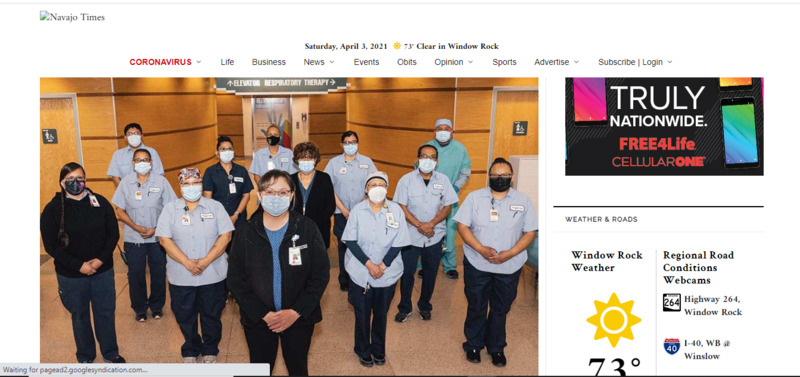 2021-03-26
2021-03-26‘They became warriors’: Reflections from the front lines as Tséhootsooí Medical Center workers share experiences
By Rima Krisst | Mar 26, 2021 | CORONAVIRUS, People | Tséhootsooí Medical Center workers share experiences Wilberta “Billy” Jackson, public health nurse III This pandemic has been the longest roller coaster of stress, grief, and loss. I’ve kept my routine simple – sleep, eat, and exercise. And, more sleep. This has been and will probably be the most challenging time of our lives. I could focus on all the bad, but so much good has come from this, from community members stepping up, leaders rolling their sleeves up and getting dirty, how we came together to care for our elders, and so much more. Professionally, we’ve adjusted and readjusted a million times over and completely changed how we deliver health care. We’ve had information, guidance, and policies being added or changing every day and we still were able to deliver health care in a safe, efficient manner. At the beginning of the pandemic, our leaders were warning everyone about the health care system being overwhelmed. Most people thought about it in terms of hospitals running out of beds, but they didn’t think of it in terms of how an underfunded and shorthanded public health force would respond to a pandemic in a rural area with limited resources, and where a population’s most basic physiological and safety needs are not being met. When you don’t have access to clean water, food, shelter and security, you’re not able to prioritize prevention measures until your basic human needs are addressed. The resiliency of the Diné people is unrivaled. The days I’m struggling or feel like giving up, I hear my grandmother’s words, and that’s what keeps me going. And my mother’s surprise delivery of Navajo soul food meals. I’m a public health nurse, so it won’t come as a surprise that I’m excited about the COVID vaccines. We’ve already seen a substantial decline in cases, hospitalizations, and deaths, so we know it’s working. My hope is that our response to the next pandemic or health care crisis won’t be complicated by politics, lack of national strategy, lack of preparation, and misinformation. Stacey Burnside, Primary Care registered nurse What I have learned from this pandemic is to cherish every day and every person that you love. COVID-19 has impacted my family and me profoundly. I lost an uncle and an aunt to COVID-19, and to this day, it is surreal that they are gone. As a primary care nurse, it is difficult to hear about losing a patient to COVID-19, and at the peak, it was almost a daily occurrence… The challenges that I faced during this pandemic were adapting to the changes in work roles and being separated from the people I love. The clinic that I worked in was closed when the pandemic hit the first peak, and I, along with my coworkers, was informed that we had to work in the Emergency Room. The moment that I saw a patient who needed me to be their nurse, despite having COVID-19, humbled me. That moment in the ER humanized COVID-19 for me and made me realize that I was put there for a reason. No matter what the situation is, nurses adapt, and the teamwork and strength we draw upon each other are phenomenal. A huge hit to me personally and professionally was losing a friend to suicide … dealing with grief, loss, and stress has been a daily thing. What has helped me is drawing strength from my God, husband and son, and family. There are many negatives to the pandemic, but one positive that many have seen is the love and strength we have found among our families. I am thrilled that we are at a point of a high vaccination rate in the Navajo Nation. I remember when I administered my first COVID-19 vaccine to a patient, it brought tears to my eyes, and I cried after work. Leah Chattin, respiratory therapist I’ve been a respiratory therapist since 2003. What I experienced throughout the first surge of COVID-19 here on Dinetah is not what you prepare for. I see the impact on my life as deep internal scars that I buried and to resurface those experiences is a nightmare. Imagine the inability to fully take a deep breath, something so simple we take for granted. Supporting my patients with breathing treatments, providing chest physical therapy, changing breathing devices constantly because the demand for oxygen escalates all in a 12-hour or more shift. All these specialized techniques to avoid the last option of intubation, allowing an artificial airway introduced to your trachea with an opening at the tip to provide mechanical breaths from a mechanical ventilator. Fear expressed from my patients was a frequent emotion. You are alone, isolated from your family, your loved ones, no familiar face to embrace, to celebrate your improvement or the worst, a decline despite the battle you have endured. I’d remind my patients not to give up… Instinct took over because I’m a mother too, a nurturer. I can remember softly stroking their hair, holding their hands, shedding tears, praying, putting myself in that empty place at bedside where your family should be gathered, processing the grief. Accepting loss was tremendously difficult. I lost myself because I did not decompress my emotions. My spirit slivered away slowly each time my patients faced rejection of our efforts to sustain life. How I endured and sustained my sanity was prayer requests. Prayer was undoubtedly my saving grace. This virus is fluidic, the path it took was unpredictable. I strongly believe we need to continue wearing a mask, following the CDC guidelines and begin or sustain our health and wellness. Putting into words my experience was not an easy effort, however it’s a pathway for healing. Every COVID patient I battled for will forever have a place in my heart. Sandra Fouser, nurse executive of the Primary Care and Specialty Clinics Seeing the virus cross the ocean and hit the heart of the Navajo Reservation forever changed our lives. As a health professional, I knew venturing into the unknown with limited protection meant some would survive and some wouldn’t. What I have learned working on the front lines – compassion, cohesiveness, companionship, strength, sadness and mental stress. We have been battered, beaten, praised, comforted and have also received recognition from all walks of life. I am proud to be a nurse. I believe the strength to endure comes from resiliency and the people we work with and the support of our families at home. As nurses, we cannot stand still. I feel it is in our blood to help and move forward. I have lost friends, coworkers, relatives and patients. The grief I feel is palpable, almost more than I can handle. Seeing my family, staff and patients suffer through illness and grief has been very challenging and heartbreaking. As a team, I believe when something happens to one of us, we all feel the effects, we grow closer and find comfort in each other. I see the vaccine as a progression toward eradicating the detrimental effects of this virus and giving us hope that there is a better tomorrow and that Hózhó will be restored. Dr. Karen Williams, hospitalist physician I am a Native physician (Mountain Maidu/Apache) and Indian Health Service Professional Scholar. When the pandemic started our hospitals were suddenly overwhelmed with large numbers of very ill patients needing oxygen. Some patients who worsened were placed on a “life support” or ventilators since they could no longer breathe on their own. Despite our best medical management efforts, including use of high-flow oxygen, there were patients who did not survive. I witnessed more death in a year than I have ever experienced in my career. This was traumatic for me because every day I came to work I felt like I was coming into a war zone. We saw people struggling to breathe and fighting for their life. We heard family members saying their goodbyes to their loved ones and crying over the phone. We held hands of those who took their last breath and witnessed co-workers not able to control their tears. If it were not for our team efforts, almost a military-style mentality, we could not have managed. As a hospitalist physician, the biggest challenge was ensuring that I had the most up-to-date medical knowledge to save a patient’s life. During the beginning of the pandemic many doctors throughout the country did not feel prepared. This was quickly overcome by learning medical strategies used by doctors throughout the world. The treatments used included steroids, anticoagulant medications, and high-flow oxygen. We had the support of our hospital’s incident command leadership and adapted to the changes. This included being able to offer our patients who needed oxygen a federal Drug Administration-approved “emergency use” medication called Remdesivir, and more recently Bamlavinimab for non-hospitalized patients My experiences on the front lines were psychologically and physically overwhelming … I sought support from elders and used my Native spirituality for strength. I also sought protection support from traditional Indian practitioners who set up a tipi and hogan outside the hospital for employees. I sometimes thought twice about the danger I was in. However, I acknowledged that I would never walk away. This is a result of my obligation to the Native community and the hundreds of patients I had gotten to know for so long. I “warriored up” in my mind and sought to do the best I could. I do not foresee an end to mask wearing, and now recognize how careful we all must be to protect each other. I saw too many elders get severely ill and even pass away from COVID as a result of young family members not being careful and bringing it home. I have encouraged community members and my own family to get the vaccine as soon as possible. I received two doses of the Pfizer vaccine and said a prayer in my Native way each time for protection. Natasha Topaha, certified medical assistant, Mobile Unit Overall, this year has been extremely challenging, but also has reinforced my personal strength and resiliency. I have had ongoing concerns throughout the epidemic regarding my kids’ isolation and their mental health. It has been difficult, but doable, to manage both working in health care and supporting my family both emotionally and physically. I had constant worry about bringing the virus home and infecting my family given that I was working in high risk areas and providing COVID testing, vaccines and social and mental health support to patients. I found that doing outdoor activities with my family, such as bike riding and hiking, helped me ease my stress and helped teach my children some healthy coping skills. And we could spend time together! I feel very happy and grateful in both receiving the vaccine and being able to provide it to patients and the community. I feel safer at work and at home now. Johnny Willeto Jr., facility manager/logistics chief The strength to endure comes from within yourself. For me this began in my childhood as the son of Delphine Damon Willeto and Johnny Willeto Sr., who nurtured me to become a great human being. They taught me to be a courageous, productive worker and know my limitations. As a facilities manager, my main focus and responsibilities are the protection in the physical environment of all who walk through the doors of Fort Defiance Indian Health Board’s facilities. All we knew is that COVID-19 was airborne and surface communicated. I treated it as you would tuberculosis and ensured that my staff had adequate PPE to help protect them when they are tasked with working in the patient care areas. This responsibility was a big challenge when trying to procure medical equipment such as masks, gloves, safety glasses, gowns, scrubs, and so forth. Having an MBA has allowed me to flourish in this high stress environment and to adjust with adaptations to finding supplies and creating new relationships with trustworthy suppliers. Being in close proximity to patients who are struggling with getting well can be heart wrenching. Being able to fulfill my duties in the support role to the best of my ability for my community and teammates has allowed me to sleep well at night knowing that I gave it my all. I have lost a brother-in-law who contracted the virus in the Scottsdale area of Arizona. These were very difficult times because as Navajos we are accustomed to comforting each other by a hug or handshake. With COVID, gatherings are not safe, so having family meetings for planning the funeral is off and also the funeral usually consists of 10 minutes before the burial with only a few close family in attendance. One of the biggest assets I have gained is the spiritual belief in God and keeping the communication open by saying my prayers often – to be thankful for the blessings that have come my way or when asking for strength to endure the hardships. In my free time I isolate on the Willeto Sheep Ranch in Goatsprings Valley, Arizona, where I tend 120 sheep and goats. Being able to separate the everyday stress and recharge is paramount to going forward with courage and mental sharpness to make the right choices for the organization, patients and employees. The vaccines are an effective tool to help reduce the mortality of the virus on us and give us protection to this invisible enemy. Corinne Legah, Environmental Service supervisor Personally, I was scared when I first heard of the spread of the virus overseas. It was shocking how fast the virus traveled. In the beginning our team was needed to help keep the hospital sanitized and safe for patients. We reinforced training on the cleaning process for the airborne/droplet virus. I constantly stressed wearing PPE and hand washing. I am so proud of the team for stepping up by protecting our patients. They became warriors to fight the virus. I believe without my husband’s support and God I would not have been able to cope. I have lost friends and family from this virus. It saddens me that many of our people are now in the spirit world. Being a Native and growing up with Navajo beliefs, I had to be strong. My ancestors went through so much and our people are resilient. Prayer is our strength. I cried when I watched the news when the vaccine was given to the first person in the U.S. If everyone gets their vaccine we will be able to interact with family again. I am looking forward to that day! -
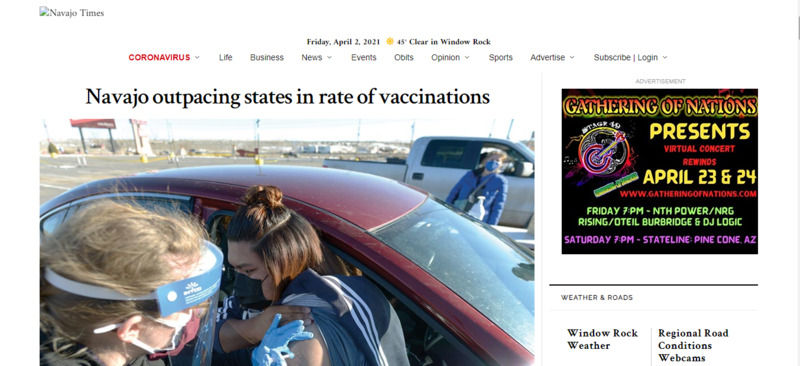 2021-03-09
2021-03-09Navajo Nation outpacing states in rate of vaccinations
By Rima Krisst | Mar 9, 2021 | CORONAVIRUS, News | WINDOW ROCK President Jonathan Nez proudly said last week that the Navajo Nation had exceeded its goal of administering 100,000 COVID-19 vaccine shots by end of February, crediting tireless health care workers who have been serving seven days a week to plan vaccinations and administer the vaccines. On Tuesday, the president’s office reported that 135,161 COVID-19 vaccine shots have gone into arms on the Navajo Nation, which represents 92% of the total 146,980 doses received and includes 48,800 persons who have had their second shots. This means that over 26% of the approximately 327,000 enrolled Navajos have gotten a shot through the Navajo Area Indian Health Service and tribal health care system, which is an amazing feat. By comparison, in New Mexico 22.4% of the population (738,705) has been given at least one shot. Arizona has administered at least one shot to 17.1% of the population (1,847,750), with Utah trailing behind at 12.2% receiving at least one shot (687,925), according to the CDC data vaccine tracker. And as of March 2, 15.3% of the U.S. population had received at least one shot, with 76.9 million shots administered, including 25.4 million receiving the second dose. Approximately 1.8 million vaccines per day are being administered daily in the U.S. So, percentage-wise, Navajo is outpacing both neighboring states and the general U.S. population. ‘Amazing partnership’ On a Feb. 25 IHS media call, IHS Chief Medical Officer Rear Adm. Michael Toedt reported that as of Feb. 18 the IHS had also achieved its goal of administering 400,000 doses of COVID-19 vaccine “across IHS, tribal, and urban Indian Health programs,” representing 16% of the “target population,” with 6.3% receiving two doses. “This milestone was reached ahead of schedule despite severe weather, making travel to health facilities difficult across much of Indian Country and leading to shipping delays,” said Toedt. Toedt said most IHS facilities have now vaccinated the majority of their priority populations and are moving into Phase 2, which includes those who work in higher risk settings such as schools and prisons. “Very shortly we expect that everyone who needs a vaccine will be able to receive it,” he said. Toedt credited IHS and tribal health care employees across the country who are committed to ensuring the protection of tribal communities in 11 geographic areas covering 26 states and 349 health facilities, many in rural and remote locations. “We have had an amazing partnership with our tribes to use all available resources to help with delivery of vaccine,” said Toedt. This included distribution and redistribution of vaccines by ground and air transportation as needed. Toedt said the IHS has also conducted over 2 million COVID-19 tests at a higher per capita than most states and is reporting a seven-day average test positivity rate of 4.5%, below the 5.6% all-races rate in the U.S., despite the fact that COVID-19 has had a disproportionate impact on American Indians/Alaska Natives. The Navajo Nation has conducted 245,085 COVID-19 tests resulting in 29,774 positive cases. ‘Developing trust’ Coordinated public relations campaigns in partnership with tribes have been key to the success of the vaccine rollout, said Toedt. Navajo Area IHS Chief Medical Officer Loretta Christensen agreed, saying public messaging has been critical. “This collaboration is one of the reasons we’ve been extremely successful,” said Christensen. “Honesty and transparency, developing that trust with the people you are serving is vital. We have spent a great deal of time on that relationship with our Navajo people to encourage them to be vaccinated.” She said the communication process has been very unified across Navajo and with the president’s office, using social media, radio, and a bilingual approach. “This is constant public education,” she said. “We encourage people in a very personal way that we would like them to be safe, keep their families, their communities safe. We feel very fortunate and grateful that our population has really stepped up.” Toedt acknowledged there has been some vaccine hesitancy relating to how quickly the vaccines were developed and whether or not they are completely safe, which has made some people distrustful. According to IHS Public Affairs Specialist Joshua Barnett, a recent IHS-funded survey by the Urban Indian Health Institute reported that 75% of Native Americans were willing to get a vaccine and 74% believe that doing so is their responsibility to help protect their community. “I’m confident that the process for vaccine development has the full integrity and completeness of time necessary to make sure these vaccines are safe, but it’s our job as healthcare providers to communicate that in a way that’s acceptable and trusted by our population,’ said Toedt. “We know our efforts are working and we’re seeing good delivery and acceptance of these vaccines in our communities.” Reaching the homebound Christensen said one of the strongest assets in the Navajo vaccination campaign has been the collaboration between public health nurses and community health representatives in reaching out to community members at the local level, including homebound elders and persons with disabilities. “These are the people out in the rural areas that know the families, that know the homes,” said Christensen. “We rely on them for that person-to-person contact out in the communities.” She said between 4,000 to 5,000 homebound individuals have actually been vaccinated at home or close to home. Moving forward with the goal of getting the Navajo population vaccinated and achieving “community immunity,” Navajo Area IHS wants to make sure that all 27,000 square miles of the Nation have been penetrated, said Christensen. “We want to be able to target any communities, populations or subgroups that have perhaps maybe not been able to get vaccinations,” she said. “So, our first step is to heat-map our whole area and then focus on those populations that are perhaps more rural or don’t have easy access to healthcare facilities.” “Our goal is to get every single person vaccinated and to keep our populations in Arizona, New Mexico and Utah safe,” she said. Christensen said her team will be working with chapters to identify anyone who might have been missed. They have also reached out to Navajos living off reservation and have established an online registry to help people find a place to get their vaccination. “We highly encourage them to come back if they need to and we will certainly take care of them and their families,” she said. Tracking variants In regard to surveillance for COVID-19 variants, Toedt said IHS does contribute its tests to state public health labs as well as different large lab corporations such as TriCore, LabCorp. and additional processes for genomic testing are in development. “The samples that are included through those mechanisms are sampled through the CDC’s processes to test for genomics,” said Toedt. Christensen said similarly the Navajo Area and the Health Command Center are working to establish more specific genomic surveillance within Navajo Nation. “In the meantime, we are participating in testing both in New Mexico and Arizona,” said Christensen. Christensen said the Navajo Epidemiology Center has also reached out to bordering states requesting any relevant information on variants be shared. “We all stand by ready to support this process and we are hopeful that we will have more specific information for Navajo Nation very soon,” she said. Christensen confirmed that she was not aware of any variants having been identified on the Navajo Nation from random sampling. “We have requested that information but we have not received it as of yet,” she said. Adverse events Any adverse events, or serious side effects, related to vaccinations within IHS are collected and reported to the same CDC system that collects the data nationally, said Toedt, but the data broken down by individual tribes is not publicly available. “We are part of that Vaccine Adverse Event Reporting System through the CDC,” said Toedt. “All adverse drug reactions are investigated by the CDC to determine what category it goes in and how they analyze data.” Navajo Area is gathering information on any adverse events on the Navajo Nation, but there are patient privacy issues when it comes to sharing that publicly, said Christensen. “We do, as (health care) institutions across Navajo Nation, share basic data with each other when we’re doing best practices,” she said. Christensen would not answer whether or not there had been any adverse events on the Nation. “I will say we have done very well with these vaccines,” she said. “There are certainly side effects which have been well defined, but we’ve had minimal significant adverse events. I cannot quantify that for you, but we are tracking those events across Navajo Nation.” Preventing transmission As far as keeping everyone safe after being vaccinated, Toedt said it’s still important to continue to wash your hands, stay six feet apart and to wear a mask. This is because vaccinated persons can theoretically still contract COVID-19 and spread it after being vaccinated, although they may not have any symptoms due to protection from the vaccine. There are also still many unknowns related to COVID-19 variants and to what extent they may evade vaccine protection, be more transmissible, or cause more serious disease. “We have been trying to report on possible variants most recently, explaining that we don’t have all the information yet on what the long term effects of those variants are,” said Christensen. “So we highly suggest that you still watch your distance, wash your hands and wear your mask.” Christensen said public messaging encouraging everyone to abide by the public health protocols in place, regardless of vaccination status, will continue until there is community immunity. -
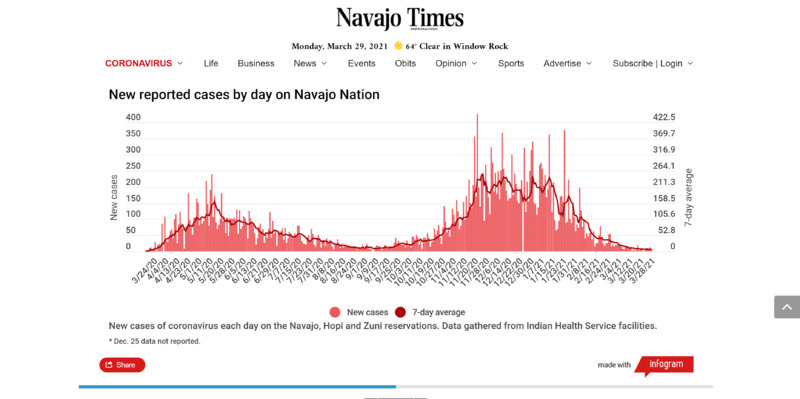 2021-03-29
2021-03-29In numbers: Tracking COVID-19 Across the Navajo Nation
In numbers: Tracking COVID-19 Across the Navajo Nation By Navajo Times | Mar 29, 2021 | CORONAVIRUS | On Sunday, Navajo Nation health officials reported 7 new COVID-19 cases. A total of 30,059 people have been sickened by the coronavirus. The rate of decrease in new cases is slowing. Nevertheless, the seven day average is 7 new cases per day, a decrease of 30 percent from the average two weeks earlier. On a per-capita basis, about 3 cases for every 100,000 people on the Navajo Nation are active. This means the Navajo Nation has the lowest per-capita cases anywhere in the 50 U.S. states. No new deaths were announced, leaving the total at 1,246 casualties of the virus. At least 16,342 people on the Navajo Nation have recovered. More than 8 of 10 people on the Navajo Nation have received at least one dose of the vaccine, or 86.3 percent of the population as of March 26, according to the Navajo Area Indian Health Service. A spokesperson for the Navajo Area IHS says 244,209 people get health care from it. Of those, 196,902 have received at least their first dose of a COVID-19 vaccine. That number includes 88,891 people, or 36.4 percent, who are fully vaccinated, according to the spokesperson. Caution is still warranted: Highly contagious variants of the virus continue to spread. The more lethal U.K. variant is doubling every 10 days throughout the United States. It now represents more than half of new U.S. cases. Many jurisdictions near the Navajo Nation are relaxing COVID restrictions. Some health experts warn that easing up right now is too soon. It could lead to an increase in new cases. Health experts recommend continued vigilance in wearing masks, social distancing, avoiding socializing with people outside your immediate household, and hand-washing. Double-masking also is recommended. For those who are fully vaccinated, the CDC still recommends wearing a mask and hand-washing; although social restrictions are more relaxed. Follow this link for complete CDC guidance for those who are vaccinated: https://www.cdc.gov/coronavirus/2019-ncov/vaccines/fully-vaccinated.html Although the Navajo Nation has relaxed some restrictions, a daily curfew remains in efffect from 10 p.m. to 5 a.m. Businesses may remain open until 9 p.m. timeline Positive Test Rate The estimated percentage of people who tested positive was 1.2 percent on Sunday. The 7-day average positive test rate was estimated at 1.9 percent. The World Health Organization recommends a 7-day average positive test rate of less than 10 percent for two weeks in a row. Localities that have a test rate of 3 percent or less are most successful in containing COVID-19, according to the WHO. At Hopi, one new cases was reported overnight, bringing the total to 1,376. The Hopi radio station reported on its Facebook page that at least 120 people have died since the pandemic began last year, but the Hopi Tribe has not consistently reported fatalities from the virus. The following charts and maps show the extent and location of the coronavirus on and near the Navajo Nation. Hover over, tap or click the map markers and graph for expanded information. (Last updated March 29, 2021 at 10:44 a.m. MDT.) Growth of COVID-19 on Navajo Nation and Hopi Reservation Cases April 2020 June 2020 August 2020 October 2020 December 2020 February 2021 0 10,000 20,000 30,000 40,000 Number Date Cases Mar 16, 2020 2 Mar 18, 2020 3 Mar 20, 2020 14 Mar 21, 2020 26 Mar 23, 2020 29 Mar 24, 2020 39 Mar 25, 2020 69 Mar 26, 2020 71 Mar 27, 2020 92 Mar 28, 2020 115 Mar 29, 2020 128 Apr 1, 2020 214 Apr 2, 2020 214 Apr 4, 2020 321 Apr 5, 2020 354 Apr 6, 2020 384 Apr 7, 2020 426 Apr 8, 2020 488 Apr 9, 2020 558 Apr 10, 2020 597 Apr 11, 2020 698 Apr 13, 2020 813 Apr 14, 2020 838 Apr 15, 2020 921 Apr 16, 2020 1,042 Apr 17, 2020 1,127 Apr 18, 2020 1,197 Apr 20, 2020 1,206 Apr 22, 2020 1,282 Apr 23, 2020 1,360 Apr 24, 2020 1,540 Apr 25, 2020 1,637 Apr 26, 2020 1,716 Apr 27, 2020 1,769 Apr 28, 2020 1,873 Apr 29, 2020 1,977 Apr 30, 2020 2,141 May 1, 2020 2,292 May 2, 2020 2,373 May 4, 2020 2,474 May 5, 2020 2,559 May 6, 2020 2,654 May 7, 2020 2,757 May 9, 2020 2,976 May 10, 2020 3,122 May 11, 2020 3,202 May 13, 2020 3,392 May 14, 2020 3,632 May 15, 2020 3,740 May 16, 2020 3,912 May 17, 2020 4,002 May 18, 2020 4,071 May 19, 2020 4,153 May 20, 2020 4,253 May 21, 2020 4,434 May 22, 2020 4,529 May 23, 2020 4,633 May 24, 2020 4,689 May 25, 2020 4,794 May 26, 2020 4,842 May 27, 2020 4,944 May 28, 2020 5,044 May 29, 2020 5,145 May 30, 2020 5,250 May 31, 2020 5,348 Jun 1, 2020 5,479 Jun 2, 2020 5,533 Jun 3, 2020 5,661 Jun 4, 2020 5,730 Jun 5, 2020 5,808 Jun 6, 2020 5,918 Jun 7, 2020 6,020 Jun 8, 2020 6,110 Jun 9, 2020 6,150 Jun 10, 2020 6,275 Jun 11, 2020 6,378 Jun 12, 2020 6,470 Jun 13, 2020 6,554 Jun 14, 2020 6,611 Jun 15, 2020 6,633 Jun 16, 2020 6,672 Jun 17, 2020 6,747 Jun 18, 2020 6,832 Jun 19, 2020 6,894 Jun 20, 2020 6,963 Jun 21, 2020 6,990 Jun 22, 2020 7,045 Jun 23, 2020 7,088 Jun 24, 2020 7,157 Jun 25, 2020 7,278 Jun 26, 2020 7,320 Jun 27, 2020 7,414 Jun 28, 2020 7,469 Jun 29, 2020 7,532 Jun 30, 2020 7,549 Jul 1, 2020 7,613 Jul 2, 2020 7,669 Jul 3, 2020 7,733 Jul 4, 2020 7,804 Jul 5, 2020 7,840 Jul 6, 2020 7,914 Jul 7, 2020 7,941 Jul 8, 2020 7,981 Jul 9, 2020 8,042 Jul 10, 2020 8,098 Jul 11, 2020 8,124 Jul 12, 2020 8,187 Jul 13, 2020 8,243 Jul 14, 2020 8,290 Jul 15, 2020 8,370 Jul 16, 2020 8,486 Jul 17, 2020 8,536 Jul 18, 2020 8,568 Jul 19, 2020 8,593 Jul 20, 2020 8,617 Jul 21, 2020 8,639 Jul 22, 2020 8,684 Jul 23, 2020 8,734 Jul 24, 2020 8,768 Jul 25, 2020 8,837 Jul 26, 2020 8,891 Jul 27, 2020 8,912 Jul 28, 2020 8,927 Jul 29, 2020 8,968 Jul 30, 2020 9,019 Jul 31, 2020 9,055 Aug 1, 2020 9,068 Aug 2, 2020 9,103 Aug 3, 2020 9,139 Aug 4, 2020 9,156 Aug 5, 2020 9,195 Aug 6, 2020 9,223 Aug 7, 2020 9,257 Aug 8, 2020 9,293 Aug 9, 2020 9,308 Aug 10, 2020 9,315 Aug 11, 2020 9,334 Aug 12, 2020 9,356 Aug 13, 2020 9,394 Aug 14, 2020 9,412 Aug 15, 2020 9,423 Aug 16, 2020 9,447 Aug 17, 2020 9,469 Aug 18, 2020 9,486 Aug 19, 2020 9,500 Aug 20, 2020 9,519 Aug 21, 2020 9,531 Aug 22, 2020 9,545 Aug 23, 2020 9,547 Aug 24, 2020 9,557 Aug 25, 2020 9,573 Aug 26, 2020 9,597 Aug 27, 2020 9,601 Aug 28, 2020 9,780 Aug 29, 2020 9,789 Aug 30, 2020 9,800 Aug 31, 2020 9,820 Sep 1, 2020 9,830 Sep 2, 2020 9,847 Sep 3, 2020 9,871 Sep 4, 2020 9,883 Sep 5, 2020 9,891 Sep 6, 2020 9,900 Sep 7, 2020 9,901 Sep 8, 2020 9,903 Sep 9, 2020 9,915 Sep 10, 2020 9,933 Sep 11, 2020 9,952 Sep 12, 2020 9,969 Sep 13, 2020 9,977 Sep 14, 2020 9,982 Sep 15, 2020 9,992 Sep 16, 2020 10,059 Sep 17, 2020 10,083 Sep 18, 2020 10,090 Sep 19, 2020 10,107 Sep 20, 2020 10,119 Sep 21, 2020 10,131 Sep 22, 2020 10,141 Sep 23, 2020 10,167 Sep 24, 2020 10,212 Sep 25, 2020 10,237 Sep 26, 2020 10,269 Sep 27, 2020 10,290 Sep 28, 2020 10,312 Sep 29, 2020 10,333 Sep 30, 2020 10,355 Oct 1, 2020 10,369 Oct 2, 2020 10,404 Oct 3, 2020 10,421 Oct 4, 2020 10,441 Oct 5, 2020 10,454 Oct 6, 2020 10,501 Oct 7, 2020 10,546 Oct 8, 2020 10,582 Oct 9, 2020 10,632 Oct 10, 2020 10,675 Oct 11, 2020 10,696 Oct 12, 2020 10,728 Oct 13, 2020 10,737 Oct 14, 2020 10,780 Oct 15, 2020 10,819 Oct 16, 2020 10,857 Oct 17, 2020 10,913 Oct 18, 2020 10,955 Oct 19, 2020 10,969 Oct 20, 2020 10,999 Oct 21, 2020 11,030 Oct 22, 2020 11,101 Oct 23, 2020 11,151 Oct 24, 2020 11,217 Oct 25, 2020 11,298 Oct 26, 2020 11,362 Oct 27, 2020 11,386 Oct 28, 2020 11,462 Oct 29, 2020 11,603 Oct 30, 2020 11,694 Oct 31, 2020 11,753 Nov 1, 2020 11,828 Nov 2, 2020 11,875 Nov 3, 2020 11,947 Nov 4, 2020 12,080 Nov 5, 2020 12,195 Nov 6, 2020 12,288 Nov 7, 2020 12,447 Nov 8, 2020 12,571 Nov 9, 2020 12,641 Nov 10, 2020 12,720 Nov 11, 2020 12,818 Nov 12, 2020 12,971 Nov 13, 2020 13,069 Nov 14, 2020 13,249 Nov 15, 2020 13,373 Nov 16, 2020 13,596 Nov 17, 2020 13,744 Nov 18, 2020 13,880 Nov 19, 2020 14,085 Nov 20, 2020 14,441 Nov 21, 2020 14,612 Nov 22, 2020 15,039 Nov 23, 2020 15,236 Nov 24, 2020 15,374 Nov 25, 2020 15,616 Nov 26, 2020 15,862 Nov 27, 2020 15,954 Nov 28, 2020 16,223 Nov 29, 2020 16,427 Nov 30, 2020 16,595 Dec 1, 2020 16,711 Dec 2, 2020 17,035 Dec 3, 2020 17,310 Dec 4, 2020 17,495 Dec 5, 2020 17,738 Dec 6, 2020 17,915 Dec 7, 2020 18,163 Dec 8, 2020 18,324 Dec 9, 2020 18,575 Dec 10, 2020 18,943 Dec 11, 2020 19,199 Dec 12, 2020 19,420 Dec 13, 2020 19,608 Dec 14, 2020 19,766 Dec 15, 2020 19,929 Dec 16, 2020 20,095 Dec 17, 2020 20,395 Dec 18, 2020 20,569 Dec 19, 2020 20,810 Dec 20, 2020 21,019 Dec 21, 2020 21,177 Dec 22, 2020 21,327 Dec 23, 2020 21,513 Dec 24, 2020 21,833 Dec 25, 2020 21,833 Dec 26, 2020 22,155 Dec 27, 2020 22,155 Dec 28, 2020 22,371 Dec 29, 2020 22,526 Dec 30, 2020 22,776 Dec 31, 2020 23,090 Jan 1, 2021 23,429 Jan 2, 2021 23,581 Jan 3, 2021 23,728 Jan 4, 2021 23,841 Jan 5, 2021 23,978 Jan 6, 2021 24,247 Jan 7, 2021 24,521 Jan 8, 2021 24,776 Jan 9, 2021 24,979 Jan 10, 2021 25,216 Jan 11, 2021 25,383 Jan 12, 2021 25,383 Jan 13, 2021 25,746 Jan 14, 2021 25,952 Jan 15, 2021 26,073 Jan 16, 2021 26,287 Jan 17, 2021 26,383 Jan 18, 2021 26,448 Jan 19, 2021 26,517 Jan 20, 2021 26,612 Jan 21, 2021 26,782 Jan 22, 2021 26,955 Jan 23, 2021 27,109 Jan 24, 2021 27,484 Jan 25, 2021 27,573 Jan 26, 2021 27,665 Jan 27, 2021 27,887 Jan 28, 2021 27,987 Jan 29, 2021 28,075 Jan 30, 2021 28,217 Jan 31, 2021 28,325 Feb 1, 2021 28,388 Feb 2, 2021 28,471 Feb 3, 2021 28,544 Feb 4, 2021 28,668 Feb 5, 2021 28,796 Feb 6, 2021 28,872 Feb 7, 2021 28,897 Feb 8, 2021 28,937 Feb 9, 2021 28,994 Feb 10, 2021 29,041 Feb 11, 2021 29,098 Feb 12, 2021 29,167 Feb 13, 2021 29,205 Feb 14, 2021 29,269 Feb 15, 2021 29,283 Feb 16, 2021 29,308 Feb 17, 2021 29,336 Feb 18, 2021 29,386 Feb 19, 2021 29,464 Feb 20, 2021 29,509 Feb 21, 2021 29,535 Feb 22, 2021 29,551 Feb 23, 2021 29,576 Feb 24, 2021 29,602 Feb 25, 2021 29,655 Feb 26, 2021 29,710 Feb 27, 2021 29,719 Feb 28, 2021 29,740 Mar 1, 2021 29,754 Mar 2, 2021 29,774 Mar 3, 2021 29,794 Mar 4, 2021 29,816 Mar 5, 2021 29,838 Mar 6, 2021 29,857 Mar 7, 2021 29,866 Mar 8, 2021 29,873 Mar 9, 2021 29,887 Mar 10, 2021 29,900 Mar 11, 2021 29,911 Mar 12, 2021 29,930 Mar 13, 2021 29,945 Mar 14, 2021 29,948 Mar 15, 2021 29,954 Mar 16, 2021 29,957 Mar 17, 2021 29,968 Mar 18, 2021 29,987 Mar 19, 2021 29,992 Mar 20, 2021 29,998 Mar 21, 2021 30,007 Mar 22, 2021 30,007 Mar 23, 2021 30,010 Print COVID-19 Cases on the Navajo Reservation Presumptive Positive Tested Positive Died Recovered 0 5000 10000 15000 20000 25000 30000 Navajo Nation Chinle AZ IHS Tuba City Regional Health Care Shiprock NM IHS Gallup NM IHS Fort Defiance NM IHS Crownpoint NM IHS Kayenta AZ IHS Winslow IHS Zuni reservation Hopi reservation Utah Navajo Health System Number of cases Community Presumptive Positive Tested Positive Died Recovered Navajo Nation 0 12483 1205 16,212 Chinle AZ IHS 5496 0 0 Tuba City Regional Health Care 6 5324 0 0 Shiprock NM IHS 0 5018 0 0 Gallup NM IHS 0 4729 0 0 Fort Defiance NM IHS 0 3562 0 0 Crownpoint NM IHS 0 2861 0 0 Kayenta AZ IHS 0 2642 0 0 Winslow IHS 0 1948 0 0 Zuni reservation 0 1454 0 0 Hopi reservation 0 1372 120 0 Utah Navajo Health System 0 1064 0 0 NOTE: Navajo Nation officials have been reconciling discrepancies for July and August data. At the end of August, in a press release, the president’s office added 165 cases that occurred between April 6 and Aug. 12. Then, on Sept. 8, they added 2 more cases for July. Health officials also added 16 more deaths to the overall tally at the beginning of September. According to a news release, the deaths occurred between May and August. Officials blamed several states for delayed results. On Sept. 16, officials added 49 previously unreported cases in New Mexico. -
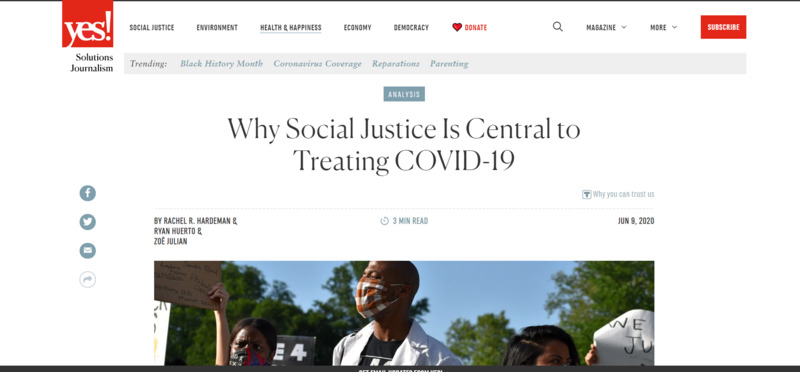 2020-06-09
2020-06-09Why Social Justice Is Central to Treating COVID-19
From article: Racism and classism create conditions where people of color, those living in poverty, and other marginalized groups have limited access to resources that affect health -
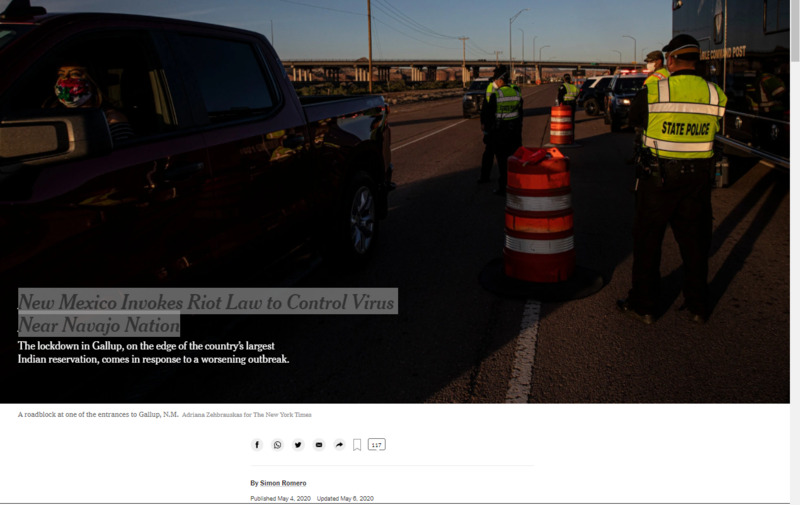 2020-05-04
2020-05-04New Mexico Invokes Riot Law to Control Virus Near Navajo Nation
This article discusses the use of a rarely used Riot Law Act to help diminish the tension between the Navajo reservation and the small towns bordering the reservation in Gallup, New Mexico. The upsurge in cases on the reservation resulted in accusations that the Navajo brought the virus into Gallup and its suburbs. The tribe has fired back that Gallup citizens are refusing to follow social distancing mandates and as a result, Gallup has one of the highest case rates in the nation. This report relates to the JOTPY archive as it an example of the friction COVID-19 has created between the local government and tribal reservations. -
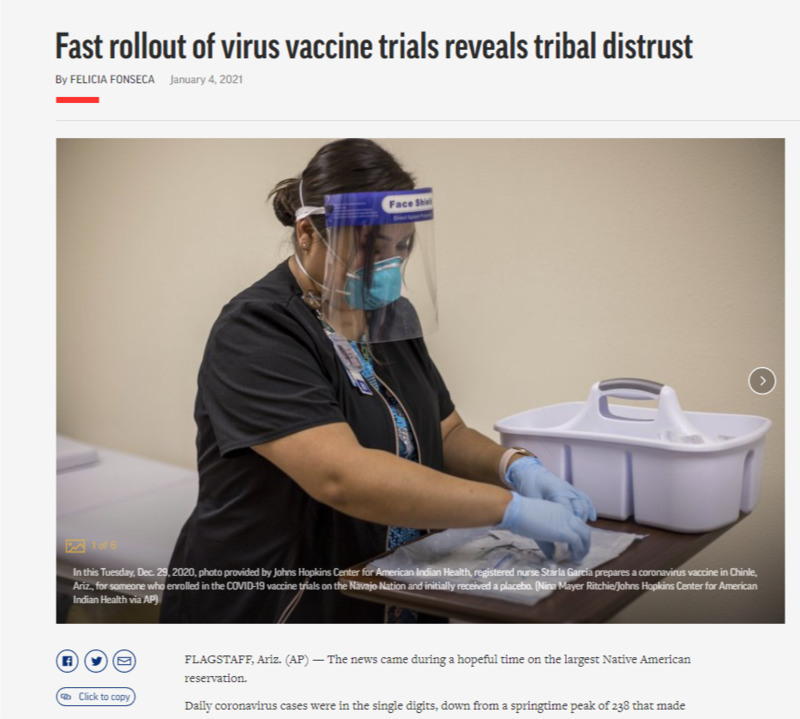 2021-01-04
2021-01-04Fast Rollout of Virus Vaccine Trials Reveals Tribal Distrust
This article discusses why the Navajo Nation is hesitant to participate in the COVID-19 vaccine trials. Although Navajo leaders approved members to participate in the trial, tribal members have expressed extreme hesitation due to lack of informed consent in past experimental trials or the unethical use of tribal medical samples for other experiments. It is important to include this piece in the JOTPY archive as it documents a COVID-19 example of the distrust tribes have held towards the government since the colonization of their lands over the past several centuries. -
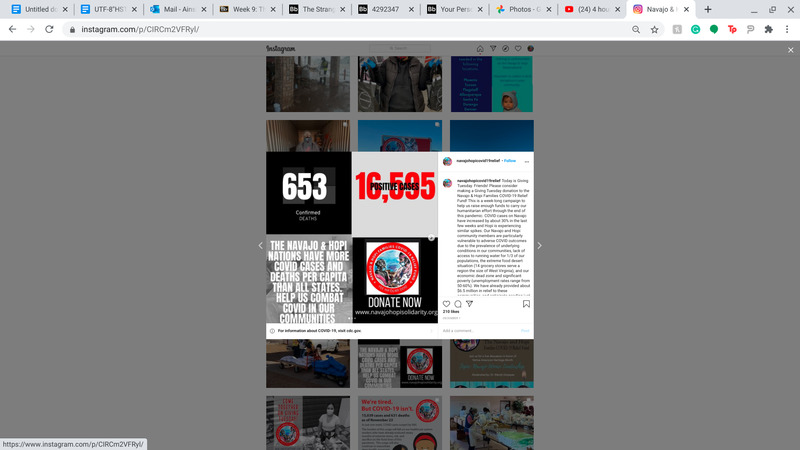 2020-12-01
2020-12-01COVID in the Navajo Nation
When I was originally planning my trip, I hoped to visit Antelope Canyon, as well as a few other parks on the Navajo Reservation, but the Navajo Nation has been one of the hardest-hit regions in the country, so by the time I was in the area, the parks were closed, and even if they had been open, I wouldn’t have felt comfortable visiting and spreading it more, even if I would have been outside and away from people. Because of that experience I wanted to take this space to try to amplify their experience. This Instagram account records the experience of an organization providing relief to members of the tribe. There are only 45 search results for Navajo in the archive, which I would constitute as an archival silence considering that many cities with comparable populations have hundreds of entries. I know that taking a screenshot of a website can only tell you so much, but it is the best way I could come up with of elevating the voices of the Navajo Nation, which is an important practice to engage within the context of archival work.
